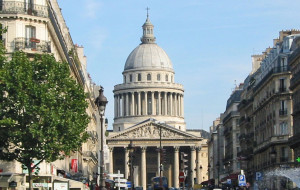Louis put his mistress’s brother in charge of making good on his promised church. He laid the cornerstone for the building in 1764, the year Madame de Pompadour, famous for her hair style, died. The neoclassical design, in the shape of the Greek cross, drew inspiration from London’s St. Paul’s Cathedral. Because of a depleted treasury, the church remained unfinished when Louis XV died in 1774. His successor, grandson Louis XVI, loaned his bankrupt government four million francs to finish it.
When the church was finally completed in 1790, it featured a massive triple dome, supported on 258 columns, extending 268 feet above the street. By that time, the French Revolution was in full swing, railing against the power of royalty and the Catholic Church. In 1791, the newly constituted National Constituent Assembly ordered that the church be transformed into a mausoleum honoring French heroes. The building took its new name, meaning “all the gods,” from the domed Pantheon in Rome. In 1792, Louis XVI was beheaded for the claimed excesses of his reign.
Twice since 1791, the Pantheon was converted to a church, each time reverting to a mausoleum as sentiments changed. Remains from 50 distinguished French intellectuals, including Voltaire, Rousseau, Victor Hugo and Madame Curie, are now enshrined in the Pantheon’s crypt. For six, only their hearts made it, manifesting the practice of removing organs before embalming. The remains of Descartes, whose transfer was authorized in 1792, have yet to arrive.
The United States Capitol architect visited the Pantheon in 1838 and made liberal use of its design concepts in the rebuilt Capitol dome. In 1851, French physicist Leon Foucault demonstrated the earth’s rotation by suspending his famous pendulum from the center of the Pantheon’s dome. The democratic rationalists of the French Revolution would be proud.
